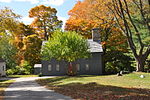St. Rocco School (Johnston, Rhode Island)
Educational institutions established in 1963Private elementary schools in Rhode IslandPrivate middle schools in Rhode IslandSchools in Providence County, Rhode Island
Saint Rocco School is a Roman Catholic parochial elementary and middle school associated with St. Rocco Parish, and located in Johnston, Rhode Island. The school opened in 1963 and was originally operated by the Apostles of the Sacred Heart of Jesus. Today, the school serves 243 students under mostly lay leadership, with a minor presence by the Daughters of Our Lady of the Garden.
Excerpt from the Wikipedia article St. Rocco School (Johnston, Rhode Island) (License: CC BY-SA 3.0, Authors).St. Rocco School (Johnston, Rhode Island)
Scalabrini Drive,
Geographical coordinates (GPS) Address Nearby Places Show on map
Geographical coordinates (GPS)
| Latitude | Longitude |
|---|---|
| N 41.7972 ° | E -71.4834 ° |
Address
Saint Rocco School Grounds
Scalabrini Drive
02920
Rhode Island, United States
Open on Google Maps







